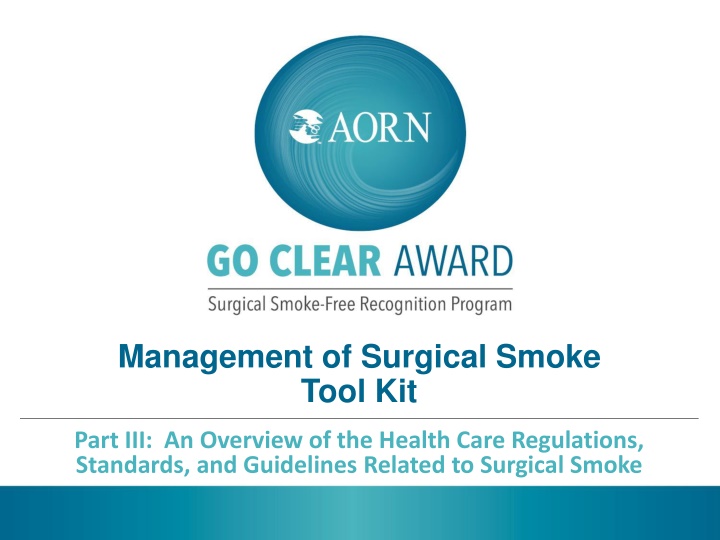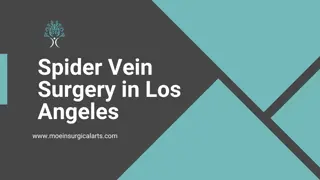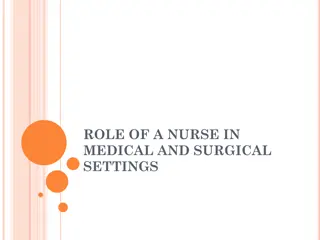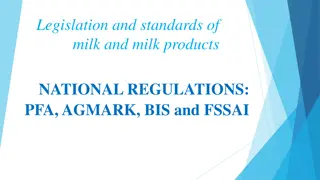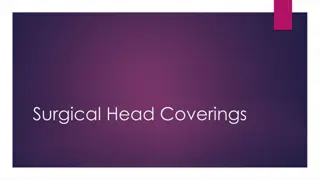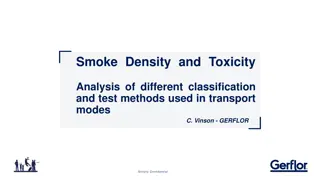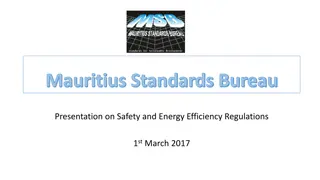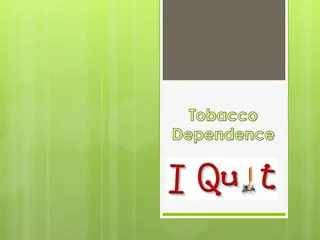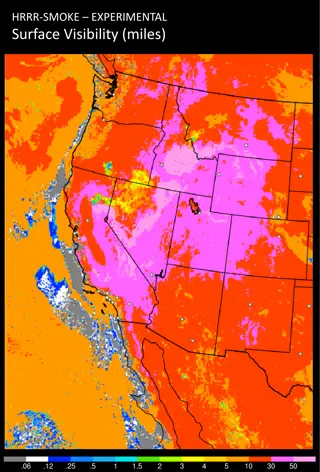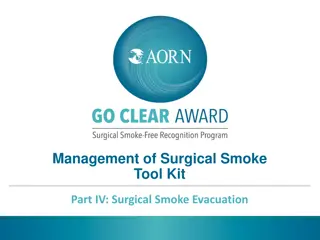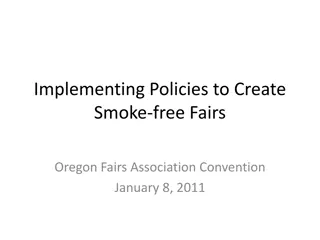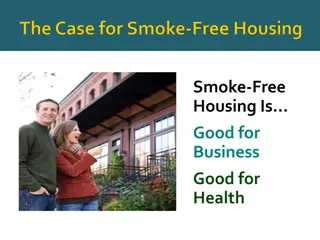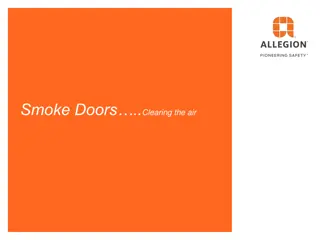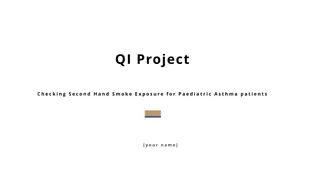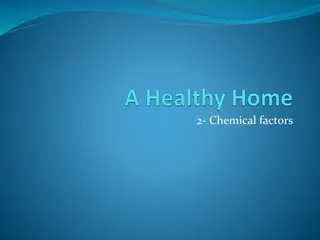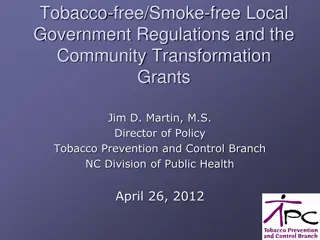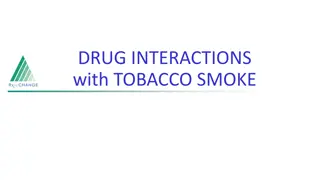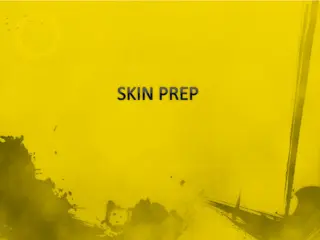Overview of Health Care Regulations and Standards for Surgical Smoke Management
This part of the surgical smoke management toolkit provides an overview of the health care regulations, standards, and guidelines related to surgical smoke. It covers various organizations such as AORN, ANSI, ECRI, IFPN, The Joint Commission, CDC, NIOSH, and OSHA, emphasizing the importance of controlling airborne contaminants through ventilation techniques and safe work practices. Following these regulations ensures a safer environment for healthcare workers and patients during surgical procedures.
Download Presentation

Please find below an Image/Link to download the presentation.
The content on the website is provided AS IS for your information and personal use only. It may not be sold, licensed, or shared on other websites without obtaining consent from the author.If you encounter any issues during the download, it is possible that the publisher has removed the file from their server.
You are allowed to download the files provided on this website for personal or commercial use, subject to the condition that they are used lawfully. All files are the property of their respective owners.
The content on the website is provided AS IS for your information and personal use only. It may not be sold, licensed, or shared on other websites without obtaining consent from the author.
E N D
Presentation Transcript
Management of Surgical Smoke Tool Kit Part III: An Overview of the Health Care Regulations, Standards, and Guidelines Related to Surgical Smoke
Instructions to the Learner This tool kit contains five slide decks related to the management of surgical smoke in the perioperative setting. We recommend that you review the slide decks in order. This is Part III. Part I: Introduction to Surgical Smoke Part II: The Hazards of Surgical Smoke Part III: An Overview of Health Care Regulations, Standards, and Guidelines Related to Surgical Smoke Part IV: Smoke Evacuation in the Perioperative Setting Part V: Additional Perioperative Nursing Care
Part III An Overview of the Health Care Regulations, Standards, and Guidelines Related to Surgical Smoke
Health Care and Regulatory Standards and Guidelines AORN American National Standards Institute (ANSI) ECRI International Federation of Perioperative Nurses (IFPN) The Joint Commission Centers for Disease Control and Prevention (CDC) National Institute of Occupational Safety and Health (NIOSH) Occupational Safety and Health Administration (OSHA)
ANSI Standard 7.4 of Z136.3 - 2011 (Safe Use of Lasers in Health Care) Airborne Contaminants: Shall be controlled by the use of ventilation (ie, smoke evacuator) and respiratory protection for any residual plume escaping capture. Note: ESUs produce the same type of airborne contaminants as lasers.
NIOSH/CDC: Ventilation Ventilation techniques include a combination of general room and local exhaust ventilation (LEV) portable smoke evacuators room suction systems
NIOSH/CDC: Work Practices The smoke evacuator or room suction hose nozzle inlet must be kept within 2 inches of the surgical site. The smoke evacuator should be ON (activated) at all times when airborne particles are produced. Health care workers should follow standard precautions.
Follow Standard Precautions at the Completion of the Procedure All smoke evacuator tubing and filters considered infectious waste disposed of appropriately New tubing should be installed on the smoke evacuator for each procedure Change filters according to manufacturer s instructions LEV equipment regularly inspected and maintained
OSHA General Duty Clause: Employer MUST provide a safe workplace environment!
OSHA Respiratory Protection Recognizes: Lasers and electrosurgical plume contains toxic, mutagenic, and carcinogenic elements. Mandates and identifies: Removal of atmospheric contaminants with acceptable engineering controls and local ventilation, including smoke evacuation systems.
ECRI Independent, nonprofit organization Researches the best approaches to improving the safety, quality, and cost-effectiveness of patient care Electrosurgical smoke is overlooked. The spectral content of laser and ESU smoke is very similar.
International Federation of Perioperative Nurses (IFPN) IFPN Guideline for Smoke Plume (July 2018) Recognition that smoke particles may contain bloodborne pathogens and potential for viral transmission Identification of smoke as a workplace safety hazard Respiratory protection Use of standard precautions Use of local exhaust ventilation with ULPA filter Smoke evacuation methods
Canadian Standards CSA Z305.13: Plume scavenging in surgical, diagnostic, therapeutic, and aesthetic settings, 2013 publication Supersedes the previous edition published in 2009 Provides detailed standards on surgical smoke evacuation
AORN Guideline for Surgical Smoke Safety Includes interventions for addressing smoke evacuation: Health care organization role Perioperative team role Methods Chemical hazards Respiratory hazards Carcinogenic hazards Compliance Barriers to compliance Education Quality/performance improvement
Summary Part III Several international and national organizations have standards on the topic of exposure to hazardous materials and surgical smoke. The AORN Guideline for Surgical Smoke Safety includes interventions that address surgical smoke evacuation. Patients safety and health care workers safety concerns are addressed in health care regulations, standards, and guidelines related to surgical smoke.
End of Part III Please continue to the next slide deck: Part IV Part I: Introduction to Surgical Smoke Part II: The Hazards of Surgical Smoke Part III: An Overview of Health Care Regulations, Standards, and Guidelines Related to Surgical Smoke Part IV: Smoke Evacuation in the Perioperative Setting Part V: Additional Perioperative Nursing Care
